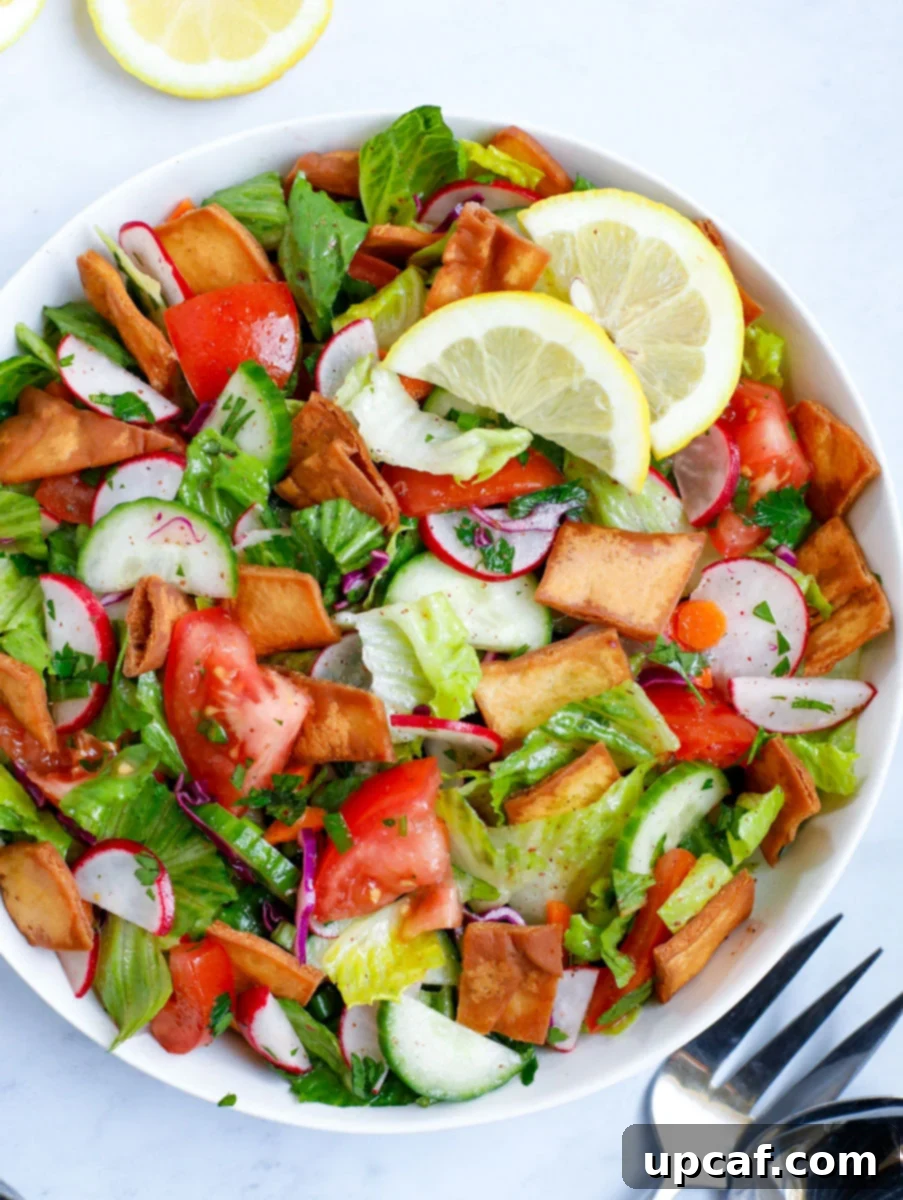Discover the vibrant flavors and refreshing textures of Lebanese Fattoush Salad, a quintessential dish in Middle Eastern cuisine that has captivated palates worldwide. This iconic Mediterranean salad harmoniously blends an array of crisp, garden-fresh vegetables and aromatic herbs with a tangy, zesty dressing, all crowned with delightful pieces of toasted or fried pita bread. Far more than just a side dish, Fattoush offers a sensory experience with its brilliant colors, invigorating aromas, and satisfying crunch, making it an ideal appetizer, a light lunch, or a perfect accompaniment to almost any meal.
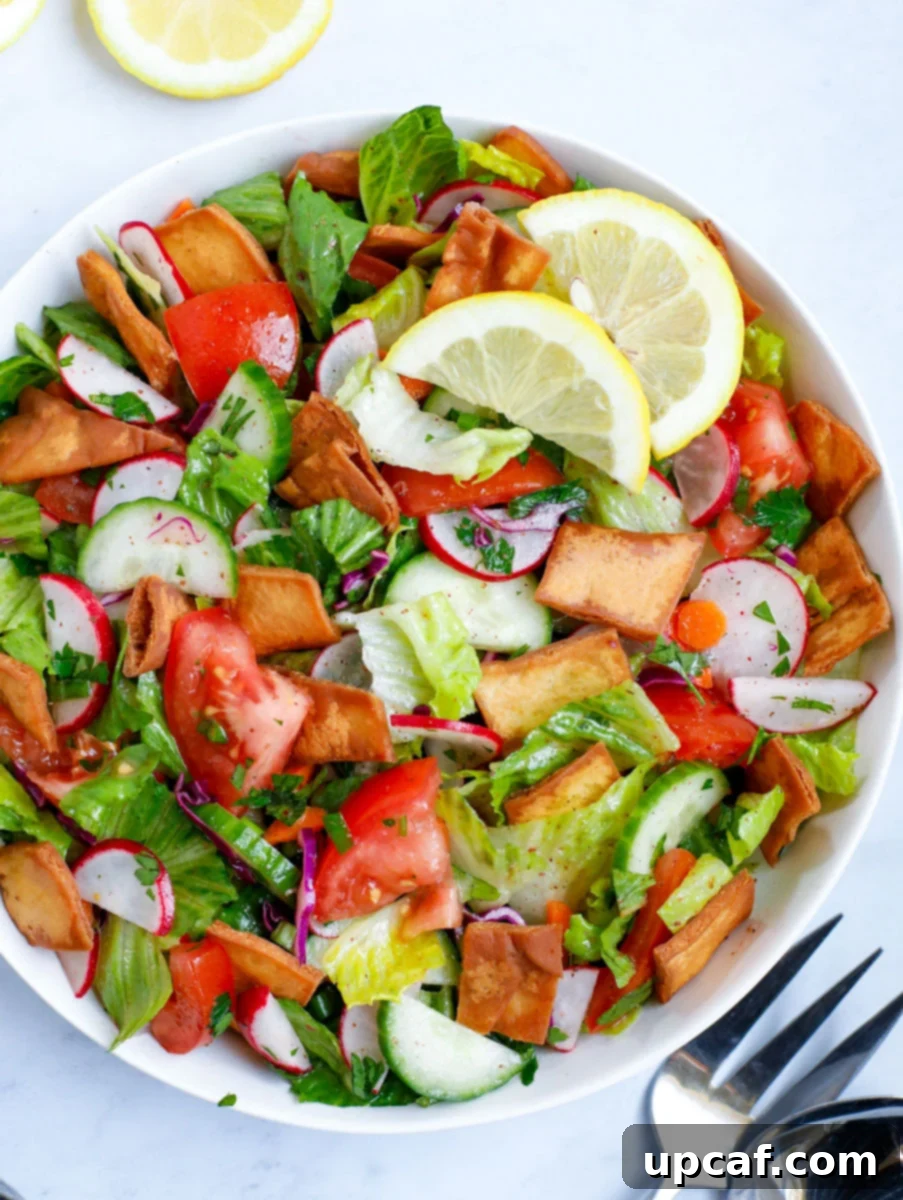
In this comprehensive guide, we’ll delve into the heart of Fattoush, exploring its rich history, breaking down each essential ingredient, and providing a foolproof, step-by-step recipe to help you recreate this culinary masterpiece in your own kitchen. Whether you’re new to Lebanese cooking or looking to perfect your Fattoush game, prepare to embark on a delicious journey that celebrates freshness, simplicity, and authentic taste.
What is Fattoush Salad? A Culinary Gem of the Mediterranean
At its core, Fattoush is a traditional Mediterranean salad renowned for its use of well-seasoned, crispy fried or toasted pita bread, combined with a colorful assortment of fresh vegetables and a distinctively tangy dressing. It stands as a beloved staple in Lebanese cuisine and enjoys immense popularity across the broader Middle East. More than just a meal component, Fattoush embodies the spirit of Levantine cooking – fresh, flavorful, and deeply rooted in local produce.
The name “Fattoush” itself offers a clue to its most distinctive element. Derived from the Arabic word “fattah,” meaning “crumbs” or “to break,” it directly references the broken, crispy pieces of pita bread that are central to the salad. These pita croutons are not merely an afterthought; they are the star of the dish, contributing a unique crunchy texture and a subtle, savory flavor that elevates the entire salad.
Historically, Fattoush emerged as a resourceful dish, making use of stale pita bread by toasting or frying it, transforming what might otherwise be discarded into a delicious and textural component. This tradition of using leftover bread is common in many cuisines worldwide, and Fattoush is a prime example of how ingenuity can create enduring culinary classics. The salad is often served as a refreshing side dish or appetizer, frequently paired with hearty grilled meats, kebabs, or stews, but it is equally delightful when enjoyed on its own as a light, healthy, and satisfying meal.
The dressing, a simple yet powerful combination of lemon juice and extra virgin olive oil, is the backbone of Fattoush’s bright flavor. What sets it apart are the key seasonings: sumac, a deep red spice with a unique tart, almost citrusy flavor, and pomegranate molasses, a thick, dark syrup that adds a sweet-tart complexity and a beautiful glaze. These ingredients are indispensable, giving Fattoush its signature tang and depth that tantalize the taste buds and leave a lasting impression.
Looking for more authentic Lebanese recipes to expand your culinary repertoire? Explore delights like Sheikh El Mahshi (شيخ المحشي) or the savory Lebanese Kibbeh (Kibbeh bil Sanieh), and let the flavors of the Levant transport you.
Why You’ll Love This Authentic Fattoush Recipe
This Fattoush Salad recipe isn’t just another dish; it’s an experience that will quickly become a cherished favorite in your culinary collection. Here’s why you’ll undoubtedly fall in love with it:
- A Symphony of Bright and Flavorful Tastes: Prepare for a true feast for your senses! Each bite bursts with the freshness of crisp vegetables, the fragrant notes of fresh herbs, and the invigorating tang of a perfectly balanced dressing. The vibrant medley of ingredients creates a refreshing and utterly delicious profile that awakens the palate.
- Remarkably Customizable to Your Liking: One of Fattoush’s greatest charms is its inherent flexibility. This recipe provides a foundational, authentic base, but it’s incredibly easy to adapt to your personal tastes, dietary preferences, or whatever fresh produce you have on hand. Feel free to explore endless variations, adding different vegetables, proteins, or even a sprinkle of cheese to make it uniquely yours.
- Unparalleled Versatility for Any Occasion: Whether you need an elegant appetizer for a dinner party, a refreshing side dish for a casual barbecue, a light and healthy lunch, or a vibrant addition to a holiday spread, Fattoush fits the bill perfectly. Its crowd-pleasing appeal ensures it pairs beautifully with virtually any main course, from grilled meats to vegetarian mains, or stands strong as a fulfilling meal on its own.
- A Wholesome and Nutritious Choice: Packed with an abundance of fresh vegetables and dressed with heart-healthy extra virgin olive oil, Fattoush is not just delicious but also incredibly good for you. It’s a fantastic way to increase your daily intake of vitamins, minerals, and fiber, making healthy eating both enjoyable and effortless.
- Quick and Easy to Prepare: Despite its sophisticated appearance and complex flavor profile, Fattoush is surprisingly simple and quick to assemble. With a little chopping and a swift preparation of the dressing, you can have this spectacular salad on your table in under 30 minutes, making it ideal for busy weeknights or impromptu gatherings.
Essential Fattoush Salad Ingredients: A Medley of Freshness
The beauty of Fattoush lies in the quality and freshness of its components. Each ingredient plays a crucial role in creating the salad’s signature taste and texture. Here’s a detailed look at what you’ll need:
The Vibrant Salad Base:
- Romaine Lettuce: The cornerstone of many great salads, romaine lettuce provides a wonderfully crisp and refreshing foundation. Its sturdy leaves hold up well to the dressing and other ingredients, adding a satisfying crunch to every bite.
- Cucumber: Essential for its cool, hydrating quality and refreshing crunch. Opt for English or Persian cucumbers for fewer seeds and thinner skins, ensuring a delicate texture.
- Carrots: While sometimes optional, carrots add a beautiful pop of color and a subtle sweetness, along with another layer of crisp texture. You can julienne them for long, delicate strips or finely grate them for a more integrated sweetness.
- Tomatoes: Juicy, sweet, and bursting with flavor, tomatoes are crucial for adding brightness and a tender counterpoint to the crispier elements. Vine-ripened tomatoes or sweet cherry tomatoes (halved or quartered) work best for optimal taste and visual appeal.
- Red Cabbage: A fantastic addition for its striking purple hue and a distinct, slightly sharp bite. Finely shredded red cabbage contributes an impressive crunch and vibrant visual interest to the salad.
- Green Onions (Scallions): These milder members of the onion family infuse the salad with a delicate, fresh onion flavor without overpowering the other ingredients. They add a subtle pungent note that brightens the overall profile.
- Radishes: Known for their peppery kick and crisp texture, radishes bring a refreshing zest and a lovely vibrant pink color. Thinly sliced radishes are perfect for distributing their flavor throughout the salad.
- Fresh Mint and Parsley: These aromatic herbs are non-negotiable for authentic Fattoush. Fresh mint provides an unparalleled cooling sensation and bright fragrance, while flat-leaf parsley offers earthy, herbaceous notes. Together, they lift the entire salad with their invigorating freshness.
- Pita Bread: The undisputed star of Fattoush! Transforming soft pita into crispy, golden chips (either toasted or fried) is what gives this salad its distinctive character and delightful crunch. This texture is paramount to the Fattoush experience.
The Zesty Fattoush Salad Dressing:
The dressing is where the magic truly happens, bringing all the fresh ingredients together with its unique balance of tang, sweetness, and savory notes.
- Sumac: This deep red spice is the secret ingredient for an authentic Fattoush dressing. It imparts a wonderfully tangy, slightly fruity, and almost lemony flavor that is distinctively Mediterranean and irreplaceable.
- Extra Virgin Olive Oil: High-quality extra virgin olive oil provides a rich, fruity base for the dressing, adding depth, silkiness, and a touch of healthy fat. Its robust flavor is crucial for the dressing’s body.
- Lemon Juice: Freshly squeezed lemon juice is essential for its bright, clean acidity. It cuts through the richness of the olive oil and perfectly complements the tartness of sumac, balancing all the flavors. Never use bottled lemon juice for this recipe.
- Salt: To taste, salt is vital for enhancing and bringing out the natural flavors of all the ingredients, ensuring the dressing is well-seasoned and impactful.
- Garlic (optional): A minced small garlic clove can be added for an extra layer of savory depth and a subtle aromatic kick. If you love garlic, this addition will elevate the dressing.
- Pomegranate Molasses (optional, but highly recommended): This thick, dark syrup made from reduced pomegranate juice offers a complex sweet-tart flavor profile that adds incredible depth and a glossy finish to the dressing. It’s a key element for achieving that authentic Lebanese tang with a hint of sweetness.
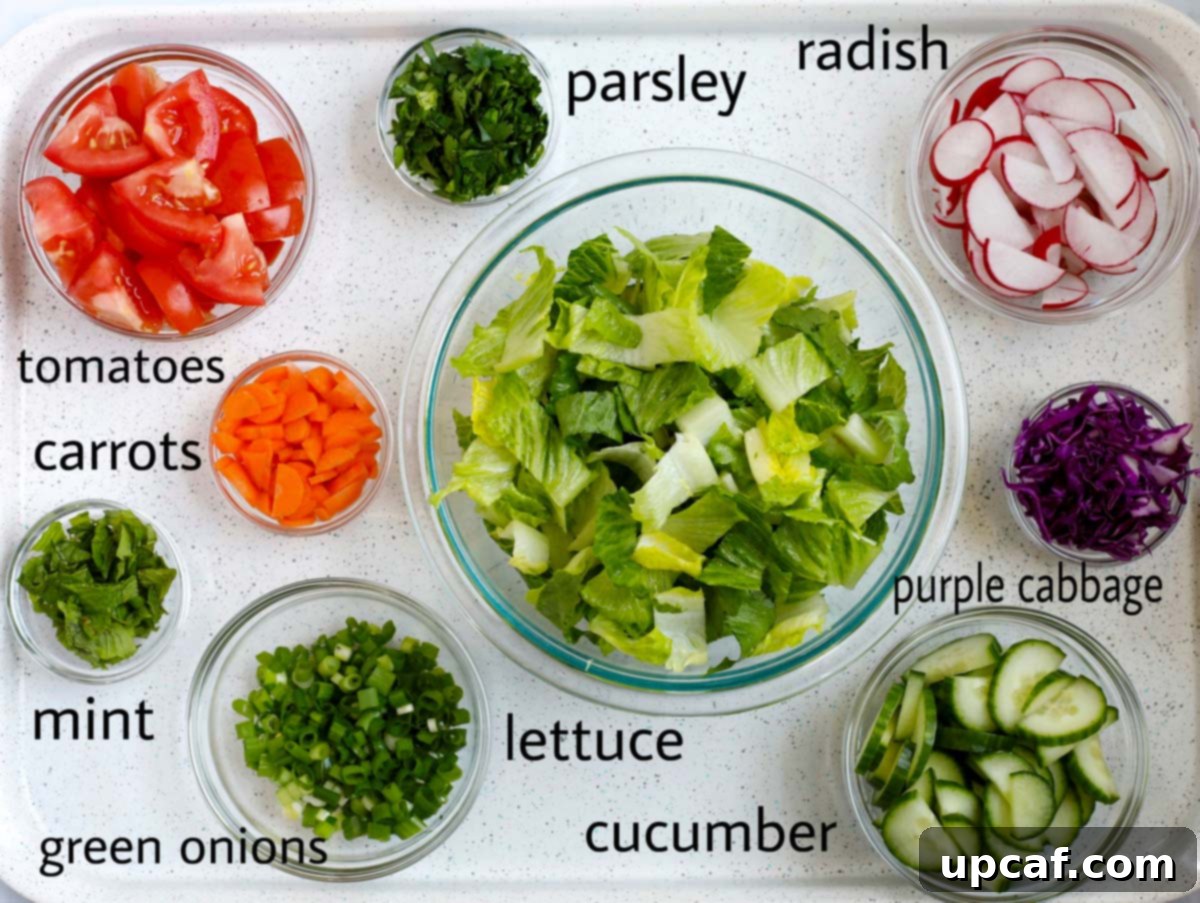
How To Make Authentic Lebanese Fattoush Salad: A Step-by-Step Guide
Crafting a delicious Fattoush salad is surprisingly simple and straightforward, allowing you to bring the vibrant flavors of the Middle East to your table with ease. Follow these basic steps to guide you through the process, ensuring a perfect result every time.
Step 1: Prepare the Pita Bread for that Signature Crunch
Begin by preparing the crucial crispy element: the pita bread. Take one loaf of pita bread and cut it into bite-sized squares or triangles. You have two excellent methods to achieve that irresistible crunch:
- Frying Method: Heat a generous amount of cooking oil (such as vegetable or canola oil) in a large skillet over medium-high heat. Once hot, add the pita pieces in batches, ensuring not to overcrowd the pan. Fry until they are beautifully golden brown and wonderfully crispy, typically 1-2 minutes per side. Remove with a slotted spoon and place on a paper towel-lined plate to drain any excess oil.
- Baking Method: For a lighter option, arrange the pita squares in a single layer on a baking sheet. Drizzle lightly with olive oil and season with a pinch of salt. Bake in a preheated oven at 375°F (190°C) for 8-12 minutes, or until golden and crisp. Keep a close eye on them to prevent burning.
Once prepared, set the crispy pita pieces aside to cool. This step can be done ahead of time to streamline your salad assembly.

Step 2: Expertly Chop and Combine the Fresh Vegetables
The heart of Fattoush lies in its fresh produce. Thoroughly wash and dry all your salad vegetables and herbs. This is a critical step to prevent a watery salad and ensure the dressing adheres beautifully. Once dry, proceed to chop all the ingredients according to the recipe’s specifications (e.g., romaine lettuce, cucumber, radishes, tomatoes, green onions, parsley, mint, carrots, red cabbage). Aim for consistent, bite-sized pieces for an appealing presentation and an even distribution of flavors and textures in every forkful. Place all the chopped ingredients into a large mixing bowl. Toss them gently to combine the vibrant medley of colors and shapes.
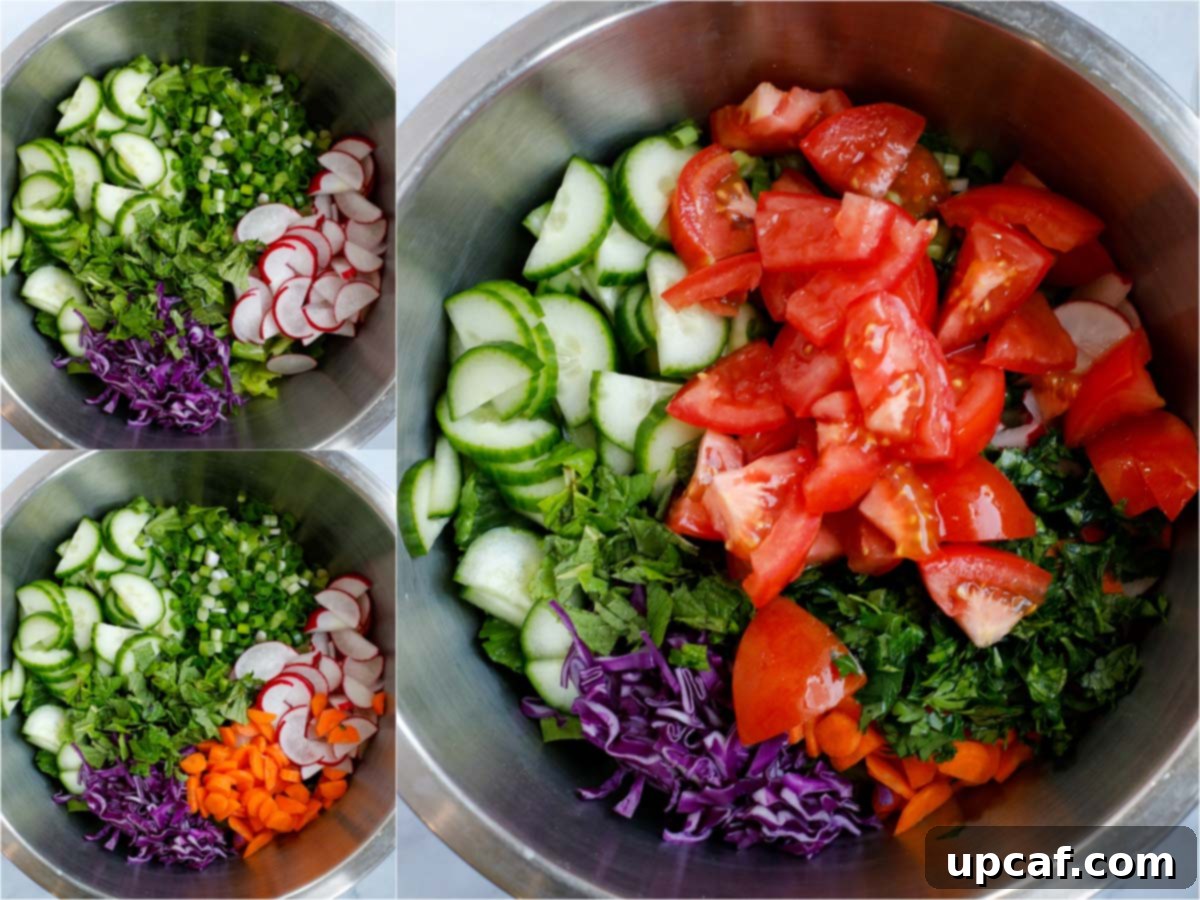
Step 3: Whisk Together the Signature Fattoush Dressing
In a separate small bowl or a measuring cup, it’s time to create the zesty and flavorful dressing that ties the entire salad together. Whisk together the extra virgin olive oil, freshly squeezed lemon juice, sumac, and salt. If you’re using minced garlic and pomegranate molasses (which we highly recommend for authentic flavor), add them now as well. Whisk vigorously until all ingredients are well combined and the dressing is emulsified. Taste and adjust the seasoning if necessary – you might want a bit more lemon, sumac, or salt to suit your preference.

Step 4: Dress the Salad to Perfection
Just before serving, pour the prepared dressing over the chopped vegetables in the large mixing bowl. Using salad tongs or your clean hands, gently toss the salad. Ensure that all the vegetables are thoroughly coated with the delicious dressing. Be careful not to over-mix, as this can bruise the delicate greens.
Step 5: Incorporate the Crispy Pita Bread
Now, add the star of the show: the toasted or fried pita bread pieces. Add them to the dressed salad and gently toss once more to combine. This final toss should be quick and gentle to ensure the pita remains as crispy as possible until it reaches the table.
Step 6: Serve Immediately and Garnish
Serve the freshly prepared Fattoush salad immediately to enjoy its optimal texture and flavor. For an extra touch of freshness and visual appeal, you can garnish the salad with a few additional fresh mint leaves or a light drizzle of pomegranate molasses, if desired. Enjoy the harmonious blend of crisp textures and tangy, aromatic flavors!
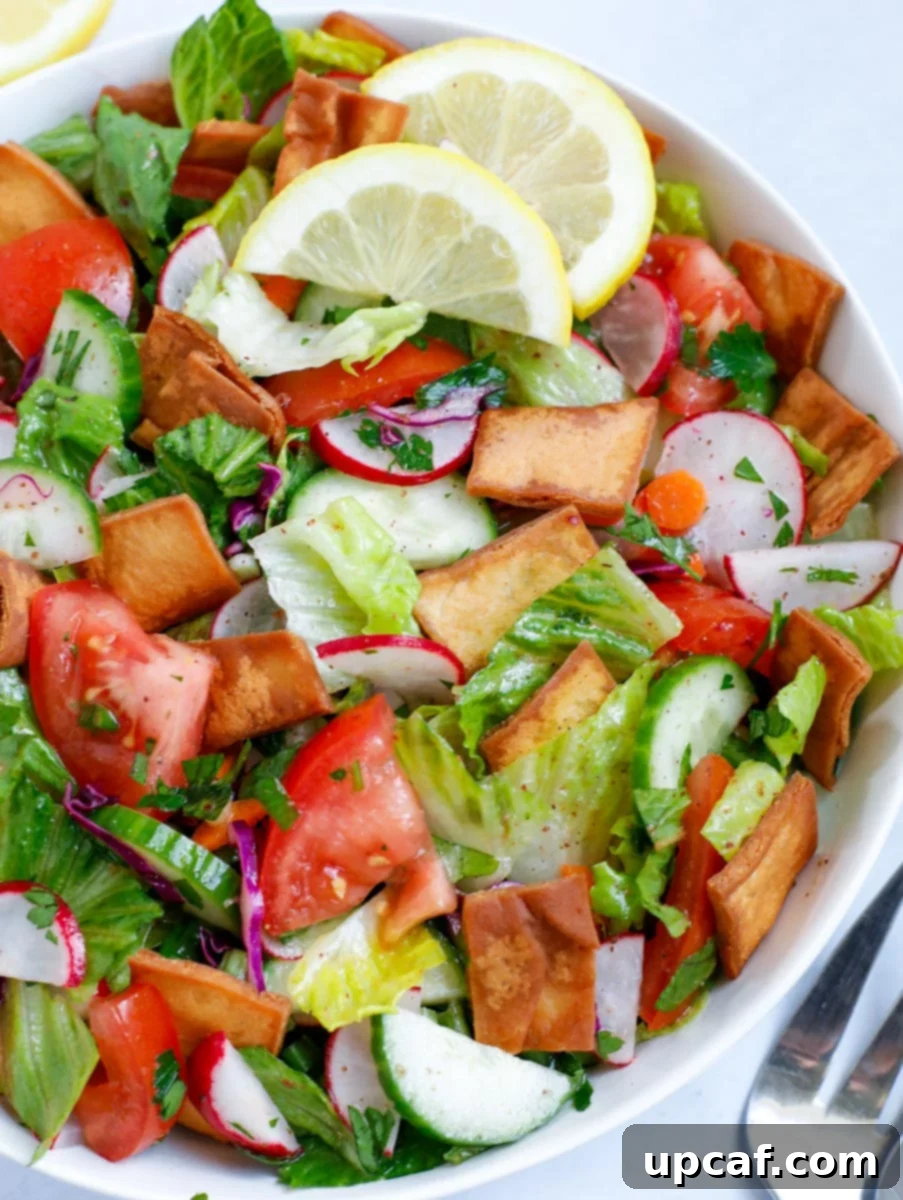
Pro Tips for Making the Best Fattoush Salad Every Time
Achieving a truly outstanding Fattoush salad goes beyond just following the steps; it’s about understanding the nuances that elevate a good salad to a great one. Here are some invaluable tips to ensure your Fattoush is nothing short of spectacular:
- Timing is Everything: Serve Immediately for Ultimate Crispiness: The biggest secret to a perfect Fattoush is serving it immediately after the final toss. The crispy pita bread is the dish’s hallmark, and it will quickly absorb the dressing and become soggy if left to sit. To maintain its delightful crunch, I highly recommend keeping the toasted or fried pita pieces separate from the dressed salad until the very moment you are ready to serve. This simple trick ensures every bite offers that satisfying textural contrast.
- Embrace Freshness: The Cornerstone of Flavor: The quality of your ingredients directly impacts the final taste of your Fattoush. Always opt for the freshest, most vibrant vegetables available. Look for crisp lettuce, firm cucumbers, ripe tomatoes, and fragrant herbs. Furthermore, using freshly squeezed lemon juice is non-negotiable for this recipe. Bottled lemon juice simply doesn’t compare in terms of brightness and natural acidity, and it can introduce unwanted preservatives or artificial flavors that detract from the salad’s authentic taste.
- Get Creative: Customize and Experiment with Additions: While the traditional Fattoush recipe is perfect as is, it’s also wonderfully adaptable. Feel free to unleash your culinary creativity! For additional layers of flavor and texture, consider incorporating other ingredients. Diced bell peppers (red, yellow, or orange) can add extra sweetness and color. Finely chopped red onions can provide a sharper, more pungent kick if you like. For a touch of fruity sweetness and a burst of jewel-like color, sprinkle in some pomegranate seeds. You could also add crumbled feta cheese for a salty, tangy creaminess, or a handful of chickpeas for added protein and heartiness, transforming it into a more substantial main course.
- Don’t Skimp on the Herbs: The generous amount of fresh mint and parsley is what gives Fattoush its distinctive fresh, aromatic profile. Don’t be shy with them; they are essential for the salad’s character.
- Balance the Dressing: The dressing is a delicate balance of tangy sumac, tart lemon, and rich olive oil, often with sweet pomegranate molasses. Taste and adjust as you go. If it’s too tart, add a touch more pomegranate molasses or a tiny pinch of sugar. If it’s too bland, more sumac or lemon juice will brighten it.
Frequently Asked Questions About Fattoush Salad
Here are answers to some common questions about making and enjoying Lebanese Fattoush Salad:
While Fattoush is undoubtedly best enjoyed fresh to preserve the crispness of both the vegetables and the pita bread, you can certainly prepare some components in advance. Chop all the salad ingredients and store them separately in airtight containers in the refrigerator. Prepare the dressing and store it in a separate sealed jar. Assemble the salad by tossing the vegetables with the dressing, and then adding the crispy pita bread, just before you plan to serve it. This method ensures maximum freshness and prevents the pita from becoming soggy.
Yes, absolutely! If you are short on time or prefer a convenient option, store-bought pita chips can be a suitable substitute for homemade ones. However, keep in mind that homemade pita bread, freshly toasted or fried, typically offers a fresher flavor and a more authentic texture that truly elevates the salad. If using store-bought, choose plain, unsalted pita chips to maintain the salad’s intended flavor profile.
Sumac is a truly essential ingredient for an authentic Fattoush, contributing its unique tangy and slightly sour flavor. While it’s highly recommended to seek it out for the best results, if you absolutely cannot find sumac, you can create a reasonable substitute. Try a mixture of lemon zest (for citrusy brightness) combined with a pinch of paprika (for color and a subtle warmth) and a tiny pinch of citric acid (for concentrated tang). This blend will mimic sumac’s profile, though the flavor won’t be identical.
To maintain the freshness and crispiness of any leftover toasted or fried pita bread, it’s best to store it properly. Place the cooled pita pieces in an airtight container, a glass jar with a tight lid, or a resealable zip-lock bag. Store it at room temperature in a cool, dry place. This will help prevent it from becoming stale or soft. Avoid refrigerating it, as the moisture can make it soggy.
What to Serve with Lebanese Fattoush Salad?
Lebanese Fattoush Salad, with its refreshing and zesty profile, is incredibly versatile and pairs wonderfully with a wide array of dishes. It’s traditionally served as a vibrant side dish or a light appetizer, but it can also shine as a standalone healthy meal. Here are a few suggestions to create a harmonious and delicious spread:
- Oven Chicken Skewers: The freshness of Fattoush beautifully complements the smoky, savory flavors of grilled or oven-baked chicken skewers.
- Harissa Chicken Tray Bake: The cooling effect of the salad balances the spiced heat of a Harissa chicken, creating a delightful contrast.
- Grilled Chicken Drumsticks: A classic pairing, where the crisp salad provides a refreshing counterpoint to tender, juicy grilled chicken.
- Mediterranean Lamb Chops: The rich, earthy flavors of lamb chops are perfectly cut by the bright acidity of the Fattoush dressing.
- Grilled Beef Kafta: The spiced minced beef in Kofta finds a perfect companion in the herbaceous and fresh notes of Fattoush.
- Charcoal Grilled Chicken: The robust, smoky flavor of charcoal-grilled chicken is wonderfully balanced by the light and zesty salad.
Beyond grilled meats, Fattoush is excellent with hummus, baba ghanoush, or alongside other Mediterranean mezze items. It also makes a fantastic, light lunch on its own, perhaps with a sprinkle of feta cheese or a few olives for added richness.
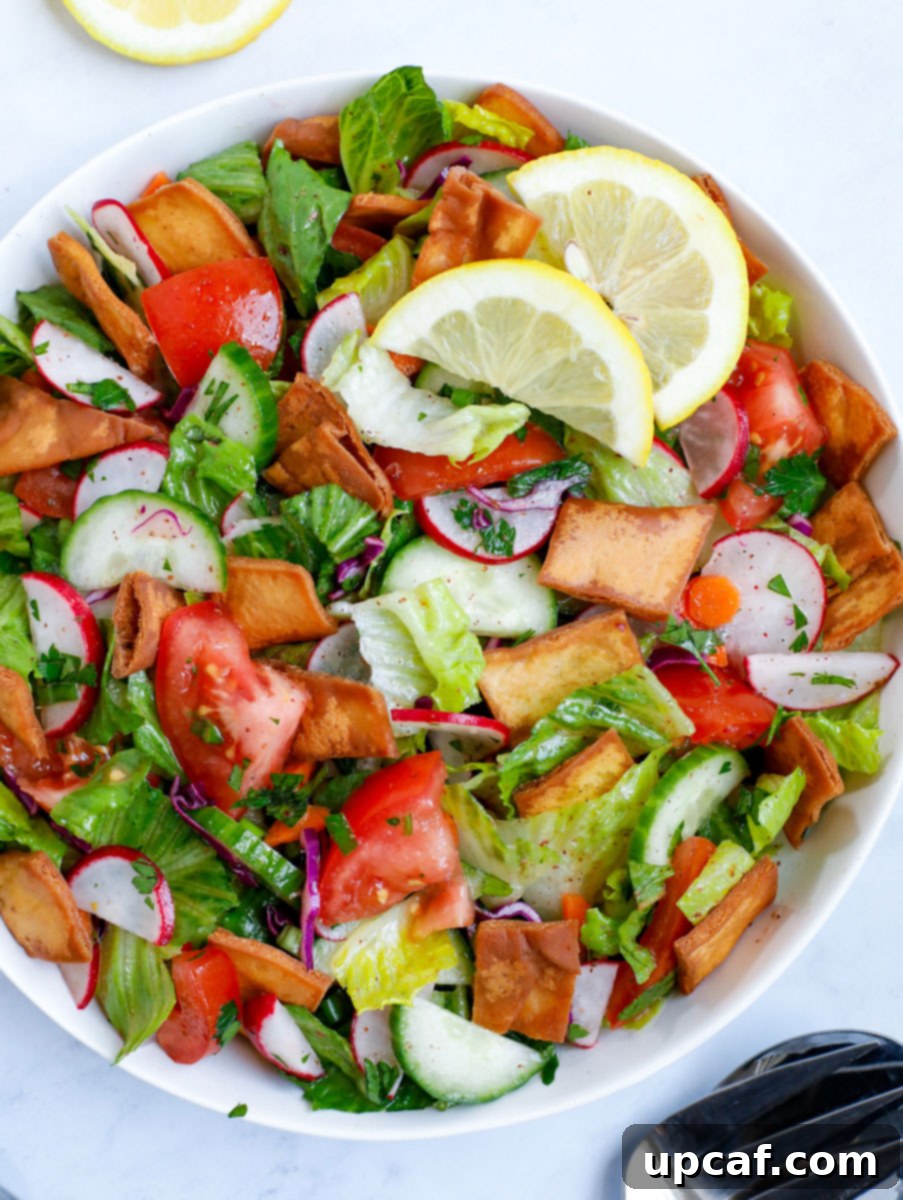
Expand Your Palate with More Lebanese Recipes
If you’ve enjoyed the delightful flavors of Fattoush, you’ll love exploring other authentic Lebanese dishes that offer a similar commitment to fresh ingredients and vibrant tastes. Here are some more Lebanese recipes to broaden your culinary horizons:
- Lebanese Chicken Lentil Soup: A comforting and hearty soup, perfect for a warming meal.
- Lebanese Tabbouli Salad: Another iconic herb-based salad, offering a different yet equally refreshing taste profile.
- Lebanese Vermicelli Rice: A staple side dish that is fluffy, flavorful, and incredibly versatile.
- Lebanese Toum (Garlic Sauce): A powerfully delicious and creamy garlic sauce that pairs well with almost anything.
- Lebanese Meat Pies (Fatayer Blahmeh): Savory individual meat pies, perfect as an appetizer or light meal.
Lebanese Fattoush Salad: A Recipe for Freshness
Lebanese Fattoush Salad is truly a celebration of flavors, textures, and unparalleled freshness. Its vibrant medley of crisp vegetables, aromatic herbs, and crunchy pita bread, all brought together by a zesty, sumac-infused dressing, creates an unforgettable culinary experience. Whether you’re enjoying it as a light and invigorating lunch, a refreshing appetizer, or a vibrant side dish to your favorite grilled meats, this authentic Fattoush recipe is guaranteed to impress and please every palate. It’s more than just a salad; it’s a burst of Mediterranean sunshine in every single bite!
If you try this delightful recipe or any of my other authentic dishes, please consider leaving a star rating and a comment in the section below. Your feedback is greatly appreciated! Also, be sure to follow Cookin’ With Mima on Facebook, Instagram, and Pinterest for all the latest social posts and delicious recipe updates.
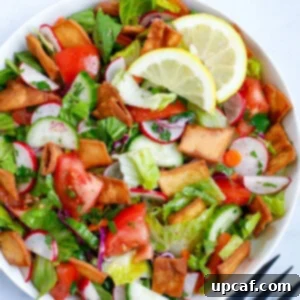
Lebanese Fattoush Salad
Ingredients
- 1 loaf pita bread, cut into cubes (either fry or bake)
- 1 medium romaine lettuce, (5-6 cups after cutting)
- 1½ cup cucumber, sliced
- 1 cup radish, sliced
- 3 medium vine ripe tomatoes, medium diced
- ½ cup green onions, chopped
- ½ cup parsley, chopped
- ⅓ cup mint, chopped
- ½ cup carrots, sliced or shredded
- ½ cup red cabbage, shredded
For the dressing
- ¼ cup lemon juice
- 1 tsp sumac
- 3 tbsps olive oil
- ½ tsp salt , to taste
- 2 tbsps pomegranate molasses, optional but recommended
- 1 small garlic clove, optional
Instructions
- Cut the pita bread into squares and either fry them with some cooking oil, or bake it in the oven with some olive oil until nice and golden in color then set it aside.
- Wash and dry the veggies really well. Chop all the salad ingredients and place them in a large mixing bowl. Toss gently to mix everything together.
- In a separate bowl or cup, whisk together the extra virgin olive oil, lemon juice, sumac, salt, and minced garlic (if using) to make the dressing.
- Pour the dressing over the salad and toss gently to coat all the ingredients with the dressing and toss to coat well.
- Add the toasted or fried pita bread pieces to the salad and toss again to combine. Taste the salad and adjust the seasoning if needed.
- Serve the Fattoush salad immediately, garnish with extra mint leaves or drizzles pomegranate molasses if desired.
Notes
- Serve Immediately: Serve the salad immediately after tossing to prevent the pita bread from becoming soggy. I recommend keeping the pita separate until serving to maintain its crispiness.
- Get Creative: For extra flavor, you can add additional ingredients such as diced bell peppers, chopped onions, or pomegranate seeds.
- Fresh ingredients: Only use fresh and flavorful veggies to keep the crunch of the veggies. Never use bottled lemon juice for this recipe.
